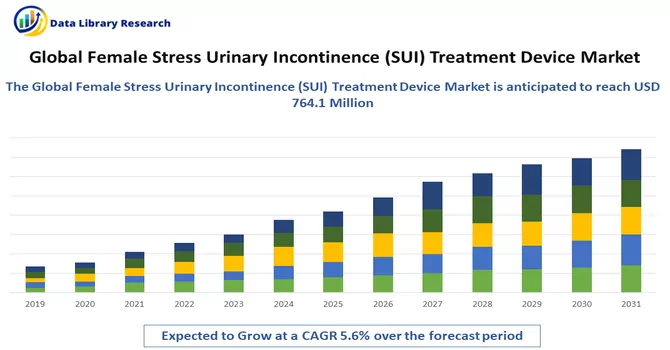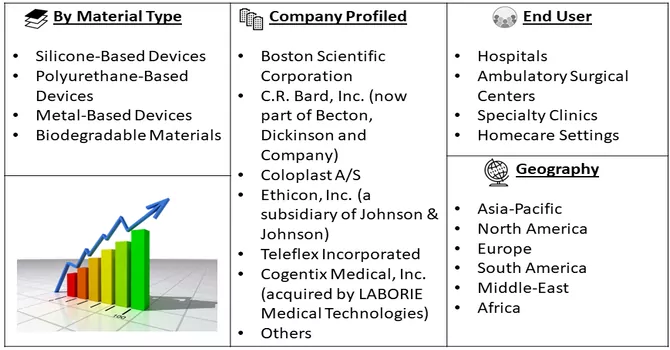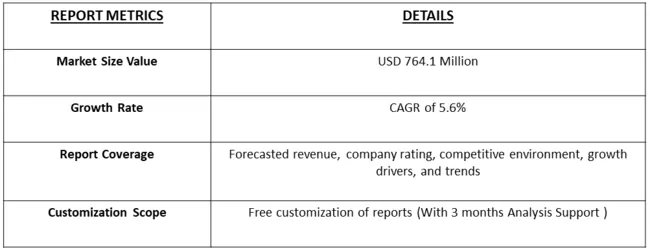The global female stress urinary incontinence treatment device market was valued at USD 764.1 Million in 2023 and is expected to register a CAGR of 5.6% over the forecast period, 2024-2031.

Get Complete Analysis Of The Report - Download Free Sample PDF
The Female Stress Urinary Incontinence (SUI) Treatment Device market is witnessing notable growth as it addresses a prevalent and often underreported health concern among women. Stress urinary incontinence, characterized by the involuntary leakage of urine during physical activities, coughing, or sneezing, has prompted increased demand for innovative and effective treatment solutions. The market encompasses a spectrum of devices designed to provide non-invasive or minimally invasive options for managing SUI, catering to the diverse needs and preferences of patients.In recent years, technological advancements and a growing awareness of women's health issues have driven the development and adoption of novel Female SUI Treatment Devices. These devices often leverage cutting-edge technologies, such as neuromodulation, biofeedback, or radiofrequency, to strengthen pelvic floor muscles, improve urethral support, and enhance continence. The market's landscape is marked by the presence of a variety of devices, including vaginal inserts, urethral slings, and electrical stimulation devices, providing healthcare professionals and patients with a range of choices based on individual conditions and preferences.With a rising focus on improving the quality of life for women affected by SUI, the market is positioned for further expansion. The ongoing efforts in research and development, coupled with a commitment to raising awareness about SUI and available treatment options, underscore the industry's dedication to addressing this significant women's health issue. As the Female SUI Treatment Device market continues to evolve, it is poised to play a crucial role in enhancing the well-being and confidence of women worldwide.
The growth of the Female Stress Urinary Incontinence (SUI) Treatment Device market is primarily driven by the increasing awareness and understanding of women's health issues, coupled with a rising prevalence of stress urinary incontinence. A growing emphasis on healthcare and the destigmatization of women's health problems have led to higher rates of diagnosis and treatment-seeking behavior. Additionally, advancements in medical technology and the development of innovative devices offer more effective and minimally invasive solutions for managing SUI.The demand for Female SUI Treatment Devices is fueled by a desire for non-invasive or minimally invasive options that provide effective results with fewer risks and complications. Technological innovations, such as neuromodulation, biofeedback, and other sophisticated approaches, contribute to the expanding repertoire of treatment devices available to healthcare professionals and patients. As the medical community continues to explore and refine these technologies, the market is expected to witness sustained growth.
Market Segmentation: The Female Stress Urinary Incontinence Treatment Device market can be segmented by Material type: (Silicone-Based Devices, Polyurethane-Based Devices, Metal-Based Devices and Biodegradable Materials) End users: (Hospitals, Ambulatory Surgical Centers, Specialty Clinics and Homecare Settings) and Geography (North America, Europe, Asia Pacific, Middle East and Africa, and South America). The market provides the value (in USD million) for the above-mentioned segments.

For Detailed Market Segmentation - Download Free Sample PDF
The market for Female Stress Urinary Incontinence (SUI) Treatment Devices is witnessing several notable trends that reflect advancements in technology, changes in patient preferences, and an evolving healthcare landscape. One prominent trend is the increasing adoption of minimally invasive and non-invasive treatment options. Patients and healthcare providers are leaning towards devices such as pelvic floor electrical stimulators and injectables that offer effective results with reduced invasiveness, quicker recovery times, and fewer complications compared to traditional surgical interventions.Another noteworthy trend is the emphasis on technological innovation and product development. Manufacturers are investing in research and development to introduce advanced devices with enhanced features, improved efficacy, and greater patient comfort. Incorporating smart technologies, wireless connectivity, and user-friendly interfaces are becoming common strategies to enhance the overall user experience and treatment outcomes.Furthermore, there is a growing trend towards patient-centric care, encouraging the development of devices that empower individuals to actively manage their condition. Portable and at-home treatment options, such as wearable pelvic floor trainers and self-administered injectables, are gaining popularity, allowing patients to integrate treatment seamlessly into their daily lives.Additionally, the market is witnessing increased collaborations and partnerships between healthcare organizations and technology companies. This collaboration aims to leverage expertise from both sectors to create comprehensive solutions that address the multifaceted challenges of stress urinary incontinence.Overall, the market trends in Female SUI Treatment Devices underscore a shift towards more patient-friendly, technologically advanced, and minimally invasive solutions, reflecting the industry's commitment to improving the quality of life for individuals affected by stress urinary incontinence.
Market Drivers:
Increasing Awareness and Acceptance:
A significant driver is the growing awareness and acceptance of female stress urinary incontinence as a prevalent medical condition. The rising acknowledgment of the impact of SUI on the quality of life has prompted more women to seek medical assistance, leading to an increased demand for effective treatment options. Moreover, healthcare professionals are playing a crucial role in educating patients about the availability of advanced treatment devices, fostering greater acceptance and adoption.
Technological Advancements and Innovation:
Continuous technological advancements and innovations in the development of treatment devices are driving the market forward. The introduction of novel technologies, such as neuromodulation, biofeedback, and advanced materials for implantable devices, has significantly improved the efficacy and outcomes of SUI treatments. Technological innovations not only enhance the performance of devices but also contribute to the development of minimally invasive and patient-friendly solutions, addressing the demand for more convenient and efficient treatment options. As a result, the market is witnessing a surge in research and development activities focused on creating cutting-edge devices that offer superior outcomes and patient satisfaction.
Market Restraints:
The Female Stress Urinary Incontinence (SUI) Treatment Device Market encounters several restraints that influence its growth trajectory. One notable restraint is the regulatory challenges associated with gaining approvals for new devices. The medical device industry operates in a highly regulated environment, requiring extensive clinical trials and regulatory clearances, which can be time-consuming and costly. This regulatory landscape can create barriers for market entry, delaying the introduction of innovative solutions and hindering market expansion. Additionally, the market faces challenges related to the limited reimbursement coverage for certain SUI treatment devices. The lack of comprehensive insurance coverage may pose financial burdens on patients and limit the widespread adoption of these devices. Addressing these regulatory and reimbursement hurdles will be crucial for the sustained growth of the Female Stress Urinary Incontinence Treatment Device Market, enabling the development and adoption of advanced and effective solutions for women's health.
The COVID-19 pandemic has significantly impacted the Female Stress Urinary Incontinence (SUI) Treatment Device Market. The healthcare sector, including elective procedures and medical device manufacturing, experienced disruptions due to lockdowns, supply chain challenges, and shifts in healthcare priorities. During the pandemic, there was a decline in elective procedures and non-urgent medical appointments, affecting the adoption of SUI treatment devices. Patients postponed elective surgeries, including those related to stress urinary incontinence, due to concerns about exposure to the virus and healthcare resource reallocation.Moreover, the pandemic highlighted the importance of healthcare resources for managing critical conditions, leading to a temporary shift in focus away from elective procedures. This shift, coupled with financial constraints faced by individuals and healthcare systems, influenced the market dynamics. However, as healthcare systems adapted to the new normal and vaccination efforts progressed, there has been a gradual recovery in elective procedures.The Female Stress Urinary Incontinence Treatment Device Market is now witnessing a resurgence as healthcare services resume and patients regain confidence in seeking elective treatments. The ongoing focus on women's health and the growing awareness of available treatment options are expected to contribute to the market's recovery post-COVID-19. Manufacturers and healthcare providers are adapting to the lessons learned during the pandemic, incorporating digital health solutions and telemedicine to enhance patient access and engagement in the post-pandemic landscape.
Segmental Analysis:
Polyurethane-Based Devices is Expected to Witness Significant Growth Over the Forecast Period
Polyurethane-based devices represent a significant segment within the female stress urinary incontinence treatment device market. These devices are favored for their durability, flexibility, and biocompatibility, making them suitable for long-term implantation in the body. Polyurethane-based devices offer advantages such as reduced risk of infection, improved patient comfort, and enhanced efficacy in providing urinary continence. They are commonly used in the manufacturing of urethral inserts, vaginal inserts, and other implantable devices designed to support the bladder and urethra. With advancements in material technology and increasing demand for minimally invasive treatment options, the market for polyurethane-based female stress urinary incontinence treatment devices is poised for substantial growth in the coming years.
Specialty Clinics is Expected to Witness Significant Growth Over the Forecast Period
Specialty clinics play a crucial role in providing specialized medical care and services tailored to specific health conditions or patient populations. These clinics are often focused on particular medical specialties, such as dermatology, cardiology, oncology, or orthopedics, among others. They offer comprehensive diagnostic, therapeutic, and preventive services, along with specialized equipment and expertise to address the unique needs of patients with specific health concerns. Specialty clinics provide a more targeted approach to healthcare delivery, enabling patients to access expert care and resources in a dedicated setting. With the rising demand for specialized medical services and the increasing prevalence of chronic diseases, specialty clinics continue to be an essential component of the healthcare landscape, catering to the diverse needs of patients and contributing to improved health outcomes.
North America Region is Expected to Witness Significant Growth Over the Forecast Period
In the North America region, the market for female stress urinary incontinence (SUI) treatment devices is characterized by significant demand due to the high prevalence of SUI among women and increasing awareness about treatment options. Countries like the United States and Canada are witnessing a growing adoption of innovative treatment devices for SUI, driven by factors such as rising healthcare expenditure, favorable reimbursement policies, and advanced healthcare infrastructure. Additionally, strategic initiatives by key market players, such as product launches, collaborations, and mergers, contribute to market growth in the region. Regulatory frameworks ensuring the safety and efficacy of these devices further support market expansion. With a large patient pool and ongoing technological advancements in medical devices, the North America region is expected to remain a prominent market for female stress urinary incontinence treatment devices in the coming years.

Get Complete Analysis Of The Report - Download Free Sample PDF
The analyzed market exhibits a high degree of fragmentation, primarily attributable to the presence of numerous players operating on both a global and regional scale. The competitive landscape is characterized by a diverse array of companies, each contributing to the overall market dynamics. This fragmentation arises from the existence of specialized solution providers, established industry players, and emerging entrants, all vying for market share. The diversity in market participants is underscored by the adoption of various strategies aimed at expanding the company presence. On a global scale, companies within the studied market are strategically positioning themselves through aggressive expansion initiatives. This often involves entering new geographical regions, targeting untapped markets, and establishing a robust global footprint. The pursuit of global expansion is driven by the recognition of diverse market opportunities and the desire to capitalize on emerging trends and demands across different regions. Simultaneously, at the regional level, companies are tailoring their approaches to align with local market dynamics. Regional players are leveraging their understanding of specific market nuances, regulatory environments, and consumer preferences to gain a competitive edge. This regional focus allows companies to cater to the unique needs of local clientele, fostering stronger market penetration. To navigate the complexities of the fragmented market, companies are implementing a range of strategies. These strategies include investments in research and development to stay at the forefront of technological advancements, mergers and acquisitions to consolidate market share, strategic partnerships for synergies, and innovation to differentiate products and services. The adoption of such multifaceted strategies reflects the competitive nature of the market, with participants continually seeking avenues for growth and sustainability. In essence, the high fragmentation in the studied market not only signifies the diversity of players but also underscores the dynamism and competitiveness that drive ongoing strategic maneuvers. As companies explore various avenues for expansion, the market continues to evolve, presenting both challenges and opportunities for industry stakeholders.
Some of the key market players are:
Recent Development:
1) In 2023, The FDA's acceptance of an investigational new drug (IND) application for VMB-100, a more potent mRNA encoding human insulin-like growth factor-1 (IGF-1), for treating patients with stress urinary incontinence (SUI), is expected to drive growth in the Female Stress Urinary Incontinence (SUI) Treatment Devices Market. This milestone marks the beginning of a phase 2a open-label dose-ascending study to evaluate VMB-100's safety, tolerability, and efficacy in women with moderate SUI. The trial, scheduled to commence in the first half of 2024, highlights a significant step forward in developing innovative treatments for SUI, potentially leading to the introduction of new devices and therapies for managing this common condition.
2) In 2023, UroMems, a global company specializing in mechatronics technology for treating stress urinary incontinence (SUI), has announced a groundbreaking achievement: the first successful implant of the UroActive™ smart, automated artificial urinary sphincter (AUS) in a female patient. This development marks a significant step forward for the millions of women affected by SUI. The results from this clinical study are expected to play a crucial role in shaping UroMems' pivotal clinical trial in Europe and the U.S., potentially driving growth in the Female Stress Urinary Incontinence (SUI) Treatment Devices Market by offering a promising new treatment option for this common condition.
Q1. What was the Female Stress Urinary Incontinence (SUI) Treatment Device Market size in 2023?
As per Data Library Research the global female stress urinary incontinence treatment device market was valued at USD 764.1 Million in 2023
Q2. At what CAGR is the market projected to grow within the forecast period?
Female Stress Urinary Incontinence (SUI) Treatment Device Market is expected to register a CAGR of 5.6% over the forecast period.
Q3. Which Region is expected to hold the highest Market share?
North America Region is expected to hold the highest Market share.
Q4. What are the factors driving the Female Stress Urinary Incontinence (SUI) Treatment Device Market?
Key factors that are driving the growth include the Increasing Awareness and Acceptance and Technological Advancements and Innovation.
Data Library Research are conducted by industry experts who offer insight on industry structure, market segmentations technology assessment and competitive landscape (CL), and penetration, as well as on emerging trends. Their analysis is based on primary interviews (~ 80%) and secondary research (~ 20%) as well as years of professional expertise in their respective industries. Adding to this, by analysing historical trends and current market positions, our analysts predict where the market will be headed for the next five years. Furthermore, the varying trends of segment & categories geographically presented are also studied and the estimated based on the primary & secondary research.
In this particular report from the supply side Data Library Research has conducted primary surveys (interviews) with the key level executives (VP, CEO’s, Marketing Director, Business Development Manager and SOFT) of the companies that active & prominent as well as the midsized organization
FIGURE 1: DLR RESEARH PROCESS

Extensive primary research was conducted to gain a deeper insight of the market and industry performance. The analysis is based on both primary and secondary research as well as years of professional expertise in the respective industries.
In addition to analysing current and historical trends, our analysts predict where the market is headed over the next five years.
It varies by segment for these categories geographically presented in the list of market tables. Speaking about this particular report we have conducted primary surveys (interviews) with the key level executives (VP, CEO’s, Marketing Director, Business Development Manager and many more) of the major players active in the market.
Secondary ResearchSecondary research was mainly used to collect and identify information useful for the extensive, technical, market-oriented, and Friend’s study of the Global Extra Neutral Alcohol. It was also used to obtain key information about major players, market classification and segmentation according to the industry trends, geographical markets, and developments related to the market and technology perspectives. For this study, analysts have gathered information from various credible sources, such as annual reports, sec filings, journals, white papers, SOFT presentations, and company web sites.
Market Size EstimationBoth, top-down and bottom-up approaches were used to estimate and validate the size of the Global market and to estimate the size of various other dependent submarkets in the overall Extra Neutral Alcohol. The key players in the market were identified through secondary research and their market contributions in the respective geographies were determined through primary and secondary research.
Forecast Model
